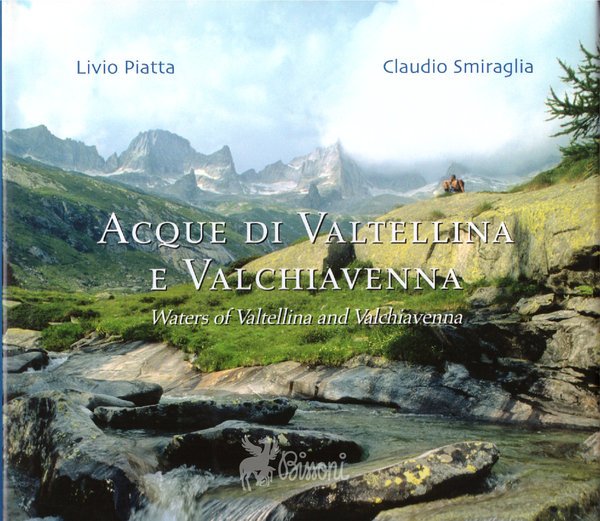
Rare and modern books
Livio Piatta - Claudio Smiraglia
ACQUE DI VALTELLINA E VALCHAVENNA
WORLD IMAGES, 2009
49.00 €
Bissoni Libreria
(SONDRIO, Italy)
The correct shipping costs are calculated once the shipping address is entered during order creation. One or more delivery methods are available at the Seller's own discretion: Standard, Express, Economy, In-store pick-up.
Bookshop shipping conditions:
For items priced over €300, it is possible to request an instalment plan from Maremagnum. Payment can be made with Carta del Docente, Carta della cultura giovani e del merito, Public Administration.
Delivery time is estimated according to the shipping time of the bookshop and the courier. In case of customs detention, delivery delays may occur. Any customs duties are charged to the recipient.
For more infoPayment methods
- PayPal
- Credit card
- Bank transfer
-
-
Find out how to use
your Carta del Docente -
Find out how to use
your Carta della cultura giovani e del merito
Details
Description
144 pp
testo bilingue: italiano e inglese
riccamente illustrato con splendide foto a colori, moltissime a piena pagina.
Che l'acqua sia fonte di vita è un'espressione tanto retorica quanto indiscutibile, acquisita da tempo immemorabile da ogni cultura che abbia lasciato traccia sul nostro pianeta. Un pianeta la cui denominazione Terra è del tutto impropria se si tiene conto che l'acqua ricopre il 70% della sua superficie. Gli si addice dunque molto di più la denominazione di pianeta blu, non certo di planeta verde per l'abbondanza delle superfici vegetate o pianela giallo per i suoi vasti deserti e neppure di pianela bianco per le tuttora vastissime calotte glaciali. Nell'acqua e dall'acqua degli oceani primitivi dell'Eone Archeano, negli imperscrutabili e incommensurabili meandri del tempo geologico, compaiono le cellule procariotiche che comprendevano le alghe verdi azzurre dei cianobatteri. Ultimo prodotto, almeno finora, dell'evoluzione, la nostra specie spesso a torto denominata ha homo sapiens, è formata per il 70% dall'acqua, che costituisce gran parte di ogni altro essere vivente.
Oltre a generare la vita, l'acqua genera paesaggi. Con i suoi continui cambiamenti di stato fisico, con i suoi vari processi di erosione, trasporto e sedimentazione, l'acqua è l'artefice dei vari volti del nostro pianela, delle pianure come delle montagne. Le regioni montane e in particolare le grandi valli alpine sono forse l'esempio migliore di quest'opera incessante di trasformazione, che vede l'erosione scolpire le valli e la sedimentazione colmarne le zone più incise, creando quel supporto morfologico che ha favorito lo sviluppo delle attività umane.
La montagna antropizzata, come la Valtellina e la Valchiavenna, assume in questo contesto la veste di un laboratorio primario, dove sperimentazioni ed equilibri millenari si sono succeduti per creare il quadro attuale di luci e di ombre che caratterizza il rapporto con l'acqua di questa regione.
Water as the source of life is an undeniable concept adopted since time immemorialby every culture that has ever left a trace on the planet, a planet with an entirely inappropriate name. moreover, Earth, given that 70% of its surface is covered by water. The title blue planet would be more fitting, the appellation green planet might work on account of its vegetation. yellow planet in honor of its vast deserts wouldn't be bad, and even white planet for its polar ice caps might do in a pinch. But it was in water, and precisely in the primitive oceans of the Archeozoic Era. in the inscrutable and incommensurate meander of geological time, that the first prokaryotic cells chose to appear, among whith the blue-green algae of cyanobacteria. And even the last product of evolution, at least for the geological moment, our own species, which with characteristic absence of modesty has baptized itself homo sapiens, happens to be composed 70% of water, the prime ingredient in every other living being as well.
In addition to generating life, water creates landscapes. Continually changing physical state, with its various processes of erosion, transport, and sedimentation, water is responsible for the planet's many faces, from the plains to the mountains. These latter and the large alpine valleys are perhaps the best example of this incessant labor of transformation through which erosion carves out the valleys and sedimentation fills them back up again to create the platform that has favored human development. In this context, humanized mountain areas like Valtellina and Valchiavenna can be seen as primordial laboratories in which Mother Nature has alternated periods of "experimentation" and equilibrium over millennia to create the current areas of light and shadow that characterize the region's relationship with water today.
Volume intatto, non letto, condizioni pari al nuovo
2 copie

